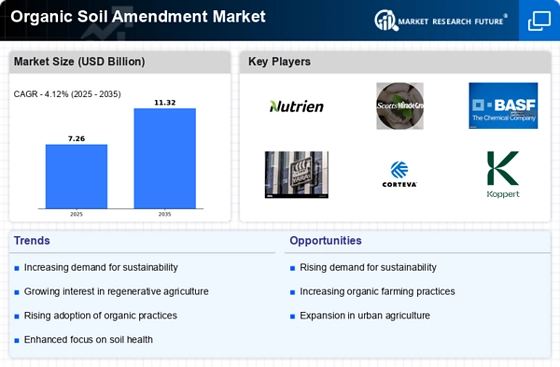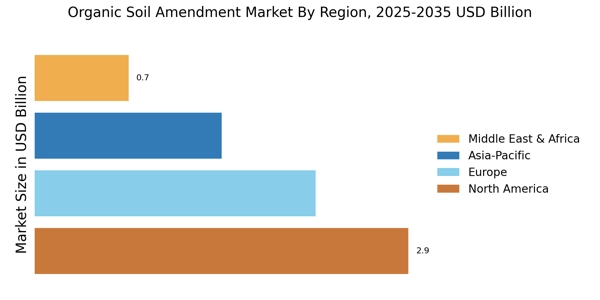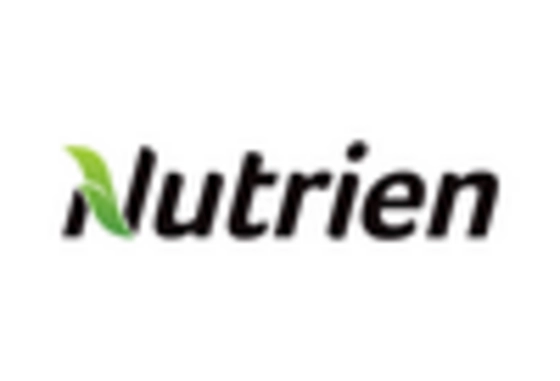Urban Agriculture Expansion
The expansion of urban agriculture is emerging as a significant driver for the Organic Soil Amendment Market. As urban populations continue to grow, there is a rising interest in local food production, leading to the establishment of community gardens and urban farms. This trend is particularly pronounced in metropolitan areas, where space constraints necessitate innovative agricultural solutions. Urban farmers are increasingly turning to organic soil amendments to enhance soil quality in limited spaces, thereby improving crop yields. The market for organic soil amendments is likely to see a surge as urban agriculture initiatives gain traction, with many cities promoting local food systems. This shift not only addresses food security concerns but also fosters community engagement, making the Organic Soil Amendment Market a vital component of urban sustainability efforts.
Sustainable Agriculture Practices
The increasing emphasis on sustainable agriculture practices is a primary driver for the Organic Soil Amendment Market. Farmers and agricultural stakeholders are increasingly adopting methods that enhance soil health and promote biodiversity. This shift is largely influenced by consumer demand for organic produce, which has seen a notable rise, with organic food sales reaching approximately 50 billion in recent years. The Organic Soil Amendment Market benefits from this trend as farmers seek to improve soil fertility and structure through organic amendments. These practices not only enhance crop yields but also contribute to environmental conservation, making them appealing to a broader audience. As sustainability becomes a core principle in agriculture, the demand for organic soil amendments is expected to grow, potentially leading to a more robust market landscape.
Regulatory Support for Organic Farming
Regulatory frameworks supporting organic farming practices are significantly influencing the Organic Soil Amendment Market. Governments and agricultural bodies are increasingly implementing policies that encourage organic farming, including subsidies and certifications. For instance, the establishment of organic standards has facilitated the growth of the organic sector, with the organic farming area expanding by over 10 million acres in recent years. This regulatory support not only legitimizes organic practices but also incentivizes farmers to transition from conventional to organic methods. Consequently, the demand for organic soil amendments is likely to rise as farmers seek compliant products that enhance soil quality and meet regulatory requirements. The Organic Soil Amendment Market stands to benefit from these supportive measures, fostering a conducive environment for growth and innovation.
Technological Advancements in Organic Farming
Technological advancements in organic farming are playing a pivotal role in shaping the Organic Soil Amendment Market. Innovations in soil testing, nutrient management, and organic amendment production are enhancing the efficiency and effectiveness of organic farming practices. For instance, the development of precision agriculture technologies allows farmers to apply organic amendments more accurately, optimizing their use and improving soil health. This trend is supported by research indicating that the use of organic soil amendments can lead to increased crop productivity and sustainability. As these technologies become more accessible, the Organic Soil Amendment Market is likely to witness a surge in demand, as farmers seek to leverage these advancements to improve their practices. The integration of technology into organic farming not only enhances productivity but also aligns with the growing emphasis on sustainable agricultural practices.
Consumer Awareness and Demand for Organic Products
Growing consumer awareness regarding the benefits of organic products is a crucial driver for the Organic Soil Amendment Market. As consumers become more informed about the health and environmental advantages of organic farming, the demand for organic produce continues to rise. This trend is reflected in the increasing sales of organic products, which have shown consistent growth, with organic fruits and vegetables leading the market. Consequently, farmers are motivated to adopt organic practices, including the use of organic soil amendments, to meet consumer expectations. The Organic Soil Amendment Market is likely to experience heightened demand as producers seek to enhance soil fertility and produce high-quality organic crops. This consumer-driven approach not only supports the market but also encourages sustainable agricultural practices.


















Leave a Comment